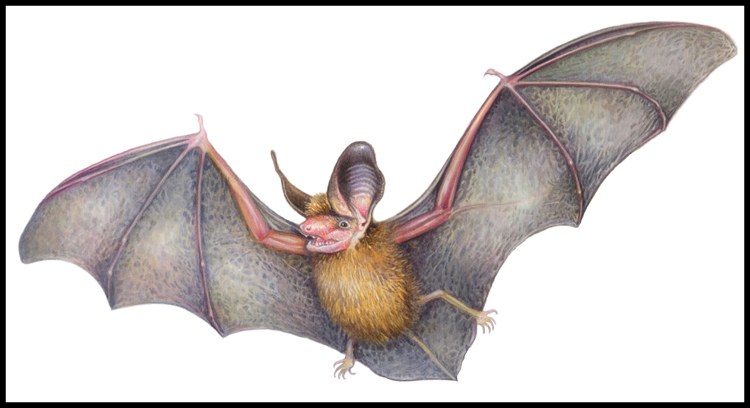Vespertilionidae
Guía de identificación de murciélagos de Chile

La taxonomía sigue las actualizaciones más recientes basadas en Simmons and Cirranello (2020a) y D'Elia et al (2020)
Eptesicus magellanicus (Philippi, 1866).
Ver notas!
Eptmag
| Parámetros | N | Min | Max | Promedio | St.Dev | 10% | 25% | 75% | 90% |
| Dur | 95 | 1.82 | 4.58 | 2.76 | 0.67 | 2.01 | 2.24 | 3.04 | 3.84 |
| TBC | 95 | 86.4 | 1304.8 | 145.8 | 133.2 | 102.3 | 108.8 | 131.2 | 168.1 |
| Fmin | 95 | 28.37 | 36.36 | 33.04 | 1.63 | 30.63 | 32.13 | 34.12 | 34.63 |
| Fmax | 95 | 37.74 | 80.00 | 54.39 | 9.98 | 44.20 | 47.06 | 61.54 | 69.09 |
| BW | 95 | 7.21 | 47.42 | 21.35 | 9.89 | 11.59 | 13.85 | 27.48 | 37.01 |
| Fmean | 95 | 33.40 | 48.10 | 39.78 | 3.13 | 36.06 | 37.67 | 41.96 | 44.68 |
| Fk | 95 | 32.52 | 41.67 | 37.87 | 2.10 | 34.72 | 36.79 | 39.32 | 40.32 |
| FcH1 | 95 | 14.24 | 18.96 | 16.93 | 0.90 | 15.88 | 16.40 | 17.47 | 17.90 |
| Fc | 95 | 28.47 | 37.91 | 33.87 | 1.80 | 31.75 | 32.79 | 34.93 | 35.81 |
| FcH3 | 95 | 42.71 | 56.87 | 50.80 | 2.70 | 47.63 | 49.19 | 52.40 | 53.71 |
| Sc | 95 | 31.28 | 276.39 | 163.36 | 37.87 | 123.59 | 146.56 | 183.00 | 199.24 |
| Pmc | 95 | 16.60 | 152.90 | 60.94 | 30.48 | 30.30 | 39.10 | 78.25 | 110.26 |
Grabado en Chile por Gonzalo Ossa
|
|
Extraído de la distribución de especies asociadas espacialmente con zonas ecológicas reconocidas para Chile (Ver Martinez et al., 2017 y Pliscoff y Fuentes-Castillo 2011)
|
|
Desde Rodríguez-San Pedro et al., 2016
|
|
Desde el nivel del mar hasta 3290 metros
I.U.C.N.: Preocupación menor Barquez y Diaz 2016.
Chile: Datos insuficientes DS 06 (2017)
Histiotus se reconoce como un subgénero de Eptesicus ya que las especies de Histiotus anidan consistentemente dentro de Eptesicus en análisis moleculares. Simmons y Cirranello (2020b), D'Elia et al 2020.
Ver Hoofer and Van Den Bussche (2003), Roehrs et al. (2010), and Amador et al. (2016).
Amador, L. I., R. L. Moyers Arévalo, F. C. Almeida, S. A. Catalano, and N. P. Giannini. 2016. Bat Systematics in the Light of Unconstrained Analyses of a Comprehensive Molecular Supermatrix. Journal of Mammalian Evolution. 25: 37-70.
Altamirano, T., J. T. Ibarra, F. Novoa, A. Vermehren, K. Martin, & C. Bonacic. 2017. Roosting records in tree cavities by a forest-dwelling bat species (Histiotus magellanicus) in Andean temperate ecosystems of southern Chile. Bosque 38:421–425.
Barquez, R. M. 2013. New distributional records for bats of the Argentine Patagonia and the. Mammalia 77:119–126.
Barquez, R. & Diaz, M. 2016. Histiotus magellanicus. The IUCN Red List of Threatened Species 2016: e.T136292A22017718. https://dx.doi.org/10.2305/IUCN.UK.2016-3.RLTS.T136292A22017718.en.
D’Elia, G. et al. 2020. Lista actualizada de los mamíferos vivientes de Chile. Boletín del Museo Nacional de Historia Natural, Chile 69:67–98.
DS 06/2017 MMA Decreto Supremo 06/2017 Ministerio del Medio Ambiente, http://www.mma.gob.cl/clasificacionespecies/decimo-tercer-proceso.htm
Díaz, M. M., G. Ossa, & R. M. Barquez. 2019. Histiotus magellanicus. Mammalian Species 51:18–25.
Giménez, A. L., N. P. Giannini, M. I. Schiaffini, & G. M. Martin. 2012. New records of the rare Histiotus magellanicus (chiroptera, Vespertilionidae) and other bats from central Patagonia, Argentina. Mastozoologia Neotropical 19:213–224.
Hoofer, S. R., and P. A. Larsen. 2003. Molecular phylogenietics of the chiropteeran family Vespertilionidae. Acta Chiropterologica. 5: 1-63.
Koopman, K. F. 1967. The southernmost bats. Journal of Mammalogy 48:487–488.
Mann, G. 1978. Los pequeños mamiferos de Chile. Gayana Concepción 40:1–342.
Ossa, G., and F. Díaz. 2014. Histiotus magellanicus (Philippi 1866), un ignorado dentro de la mastofauna chilena. La Chiricoca. 17: 5-6.
Ossa, G., L. Forero, F. Novoa, and C. Bonacic. 2015. Caracterización morfológica y bioacústica de los murciélagos (Chiroptera) de la Reserva Nacional Pampa de Tamarugal. 21-29.
Rodríguez-San Pedro, A., J. L. Allendes, and G. Ossa. 2016. Updated list of bats of Chile with comments on taxonomy, ecology, and distribution. Biodiversity and Natural History. 2: 18-41.
Rodriguez-San Pedro, A., R. M. Barquez, & J. A. Simonetti. 2015. Hisitotus magellanicus (Chiroptera: Vespertilionidae) is not restricted to Subantarctic forests: first record for the Coastal Maulino Forest in central Chile. CheckList 11:1576.
Roehrs, Z. P., J. B. Lack, and R. A. Van Den Bussche. 2010. Tribal phylogenetic relationships within Vespertilioninae (Chiroptera: Vespertilionidae) based on mitochondrial and nuclear sequence data. Journal of Mammalogy. 91: 1073-1092.
Simmons, N. B., and A. L. Cirranello. 2020a. Bat Species of the World: A taxonomic and geographic database. www.batnames.org
Simmons, N. B., and A. L. Cirranello. 2020b. Personal communication on rationale for including Histiotus under Eptesicus in taxonomic database.






